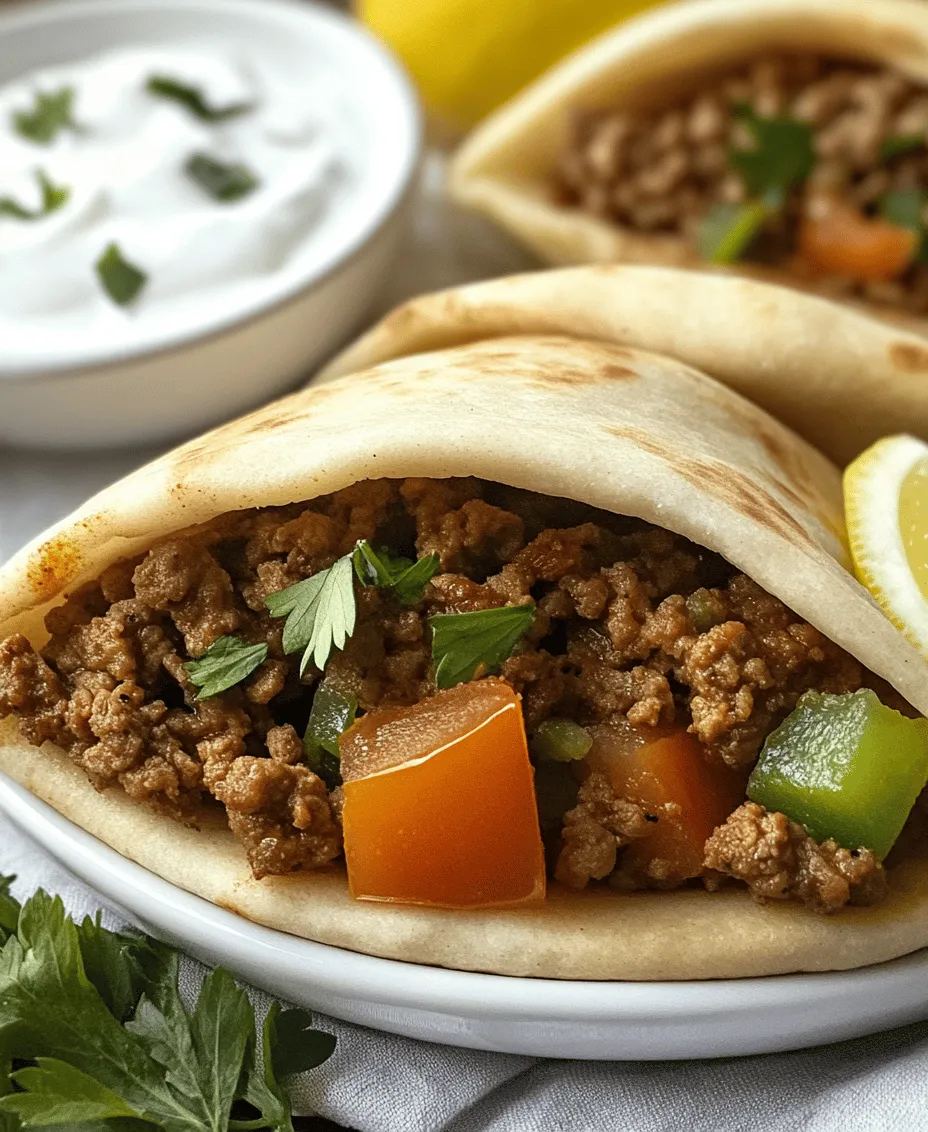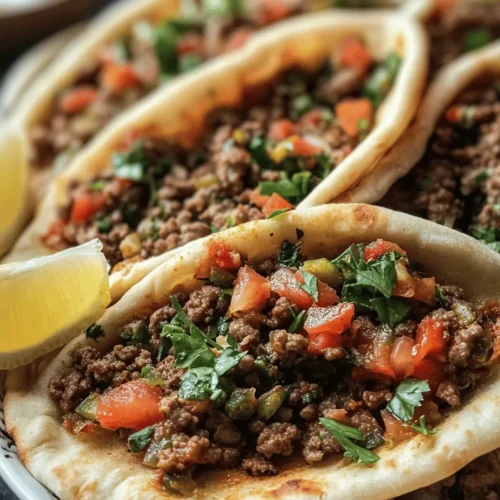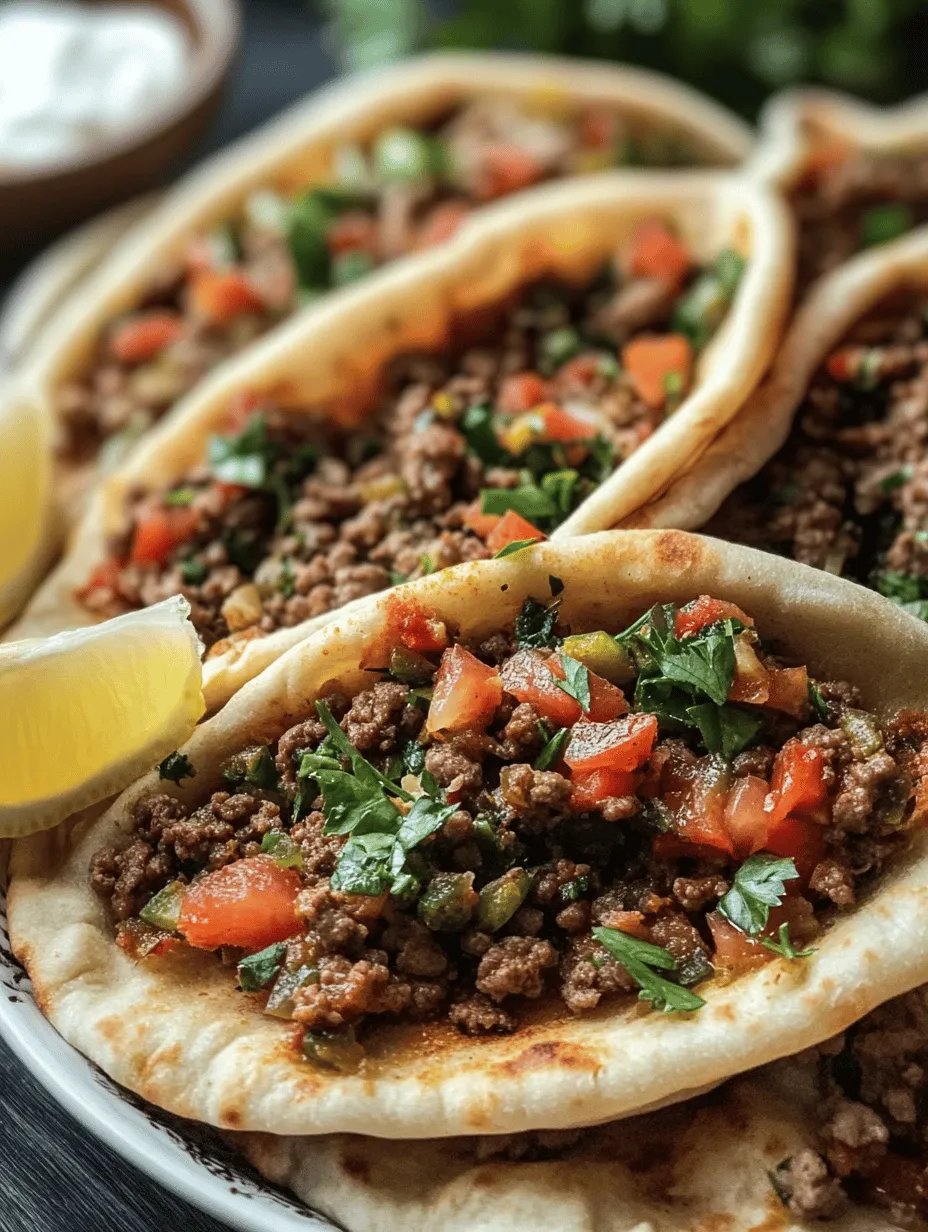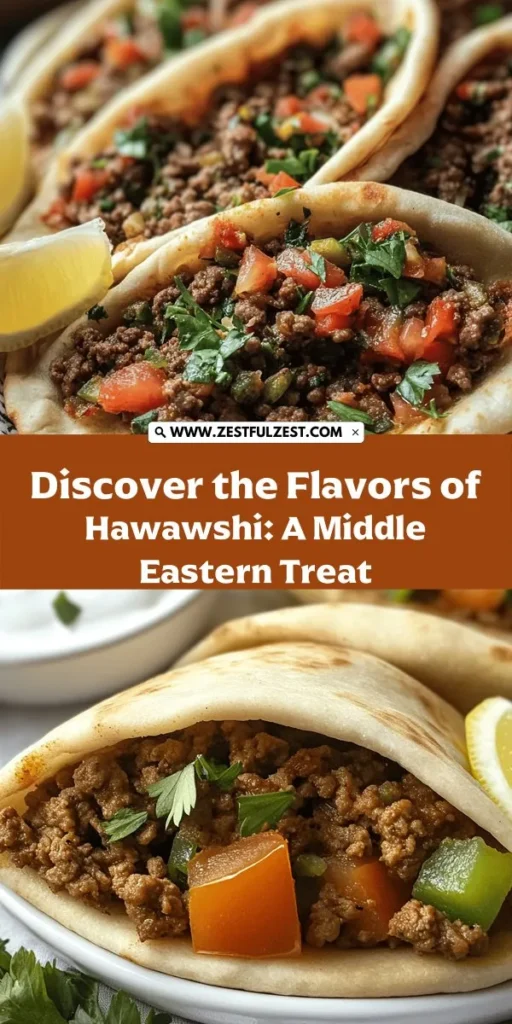Introduction
Hawawshi, a savory delight hailing from the heart of Middle Eastern cuisine, is a dish that captivates the senses with its enticing aroma and rich flavors. Originating from Egypt, this unique meat-stuffed bread has become a beloved staple not only in its homeland but also across neighboring regions. Its combination of well-spiced meat and fresh vegetables makes it an appealing choice for food lovers seeking a hearty and satisfying meal. Whether enjoyed as a quick street food treat or a comforting home-cooked dish, Hawawshi brings people together, making it a cherished culinary tradition.
The appeal of Hawawshi lies in its versatility. It can be tailored to suit various tastes and preferences, accommodating different types of meat, spices, and vegetables. This adaptability has contributed to its popularity, allowing it to be embraced by various cultures and culinary traditions. As a street food staple, Hawawshi is often found sizzling on grills, with its enticing aromas wafting through the air, drawing in hungry patrons eager to indulge in this mouthwatering dish.
In this article, we will explore the rich history of Hawawshi, its cultural significance, and how it has evolved over the years. We will also break down the essential ingredients that come together to create this delicious treat, as well as provide a step-by-step guide to making your very own Hawawshi at home.
Understanding Hawawshi
Historical Background of Hawawshi
Hawawshi has deep roots in Egyptian culinary history, reflecting the rich tapestry of flavors and traditions that characterize the region. The dish is believed to have originated in the bustling streets of Cairo, where vendors began serving meat-stuffed bread to satisfy the cravings of local residents and travelers alike. The concept of stuffing bread with various fillings is not unique to Egypt; many cultures have their own versions of stuffed bread, but Hawawshi stands out due to its distinct blend of spices and ingredients.
Origins and Cultural Significance in Egyptian Cuisine
In Egyptian cuisine, Hawawshi is more than just a meal; it is a symbol of community and hospitality. Traditionally, it is prepared for gatherings, family celebrations, and festive occasions, where friends and family come together to share food and stories. The dish has become a beloved comfort food, often associated with childhood memories and family traditions.
Over the years, Hawawshi has transcended its humble beginnings, evolving into a dish that represents the essence of Egyptian street food. It is commonly enjoyed as a quick and satisfying snack, making it a favorite among locals and tourists alike. Its presence in cafés and street stalls across Egypt showcases its popularity and importance in everyday life.
Evolution of the Recipe Over the Years
Like many traditional dishes, Hawawshi has undergone various transformations throughout its history. While the core concept of meat-stuffed bread remains, the ingredients and preparation methods have evolved to suit modern tastes and dietary preferences. Today, you can find numerous variations of Hawawshi, with creative interpretations that incorporate different spices, vegetables, and even alternative proteins.
This evolution has also been influenced by globalization, with chefs experimenting with fusion flavors and techniques. However, the essence of Hawawshi remains intact, celebrating the rich culinary heritage of Egypt while adapting to contemporary palates.
Common Variations of Hawawshi
While the classic version of Hawawshi is undoubtedly delicious, various adaptations can be found that cater to different flavor preferences and dietary needs. Some popular variations include:
– Beef Hawawshi: The most common version, featuring ground beef seasoned with spices and mixed with vegetables.
– Lamb Hawawshi: A richer alternative, using ground lamb to add depth and complexity to the flavor profile.
– Chicken Hawawshi: A lighter option that substitutes ground chicken for a healthier take on the dish.
– Vegetarian Hawawshi: A plant-based version that incorporates a medley of vegetables, legumes, and spices, appealing to non-meat eaters.
These variations allow for creativity in the kitchen, enabling cooks to experiment with different ingredients and flavors while staying true to the spirit of Hawawshi.
Different Meats Used
One of the most appealing aspects of Hawawshi is the flexibility it offers in terms of meat selection. While ground beef is the traditional choice, other meats such as lamb and chicken can be used to create unique flavor profiles.
– Ground Beef: Known for its robust flavor and versatility, ground beef is the most commonly used meat in Hawawshi. It provides a hearty base that pairs well with various spices and vegetables.
– Ground Lamb: This option offers a rich, savory taste that elevates the dish. The natural fat content in lamb also adds moisture and depth to the filling.
– Ground Chicken: A leaner alternative, ground chicken is a popular choice for those looking for a lighter option without sacrificing flavor. It absorbs spices well and can be enhanced with additional seasonings.
By selecting the meat that best suits your taste preferences, you can create a personalized version of Hawawshi that delights your palate.
Regional Adaptations and Unique Ingredients
Hawawshi is not confined to a single recipe; it varies greatly depending on the region and the cook’s personal touch. In some areas, you might find the addition of unique ingredients that reflect local tastes and culinary traditions. For instance, some variations may incorporate:
– Spicy Harissa: A North African chili paste that adds heat and complexity.
– Pine Nuts: Toasted pine nuts can lend a delightful crunch and nutty flavor.
– Dried Fruits: Ingredients like raisins or apricots may be added for a touch of sweetness that contrasts nicely with the savory meat filling.
These regional adaptations highlight the creativity and resourcefulness of cooks, showcasing how Hawawshi can evolve while remaining true to its roots.
Ingredients Breakdown
To create the perfect Hawawshi, it is crucial to use high-quality ingredients that contribute to the dish’s signature flavor and texture. Below is an overview of the main ingredients you’ll need to prepare this delectable treat.
Overview of the Main Ingredients
– Ground Beef or Lamb: The primary protein base that provides the hearty filling for the dough.
– Onion and Garlic: Essential aromatics that form the flavor foundation, adding depth and richness.
– Bell Pepper and Tomatoes: Fresh vegetables that introduce moisture and brightness to the filling.
– Spices: A blend of spices such as cumin, smoked paprika, and cayenne pepper that create the distinctive flavor profile of Hawawshi.
– Olive Oil: Enhances the overall taste and aids in the cooking process by adding moisture and richness.
– Pita Bread or Flatbread: The outer layer that encases the flavorful filling, providing a satisfying crunch when baked.
– Optional Accompaniments: Yogurt and lemon wedges for serving, adding creaminess and acidity to balance the flavors.
Importance of Fresh Produce in the Recipe
Using fresh produce is crucial to achieving the best flavor in Hawawshi. Fresh vegetables not only enhance the taste but also contribute to the overall texture of the filling. For instance, the crispness of bell peppers and the juiciness of tomatoes complement the savory meat, creating a harmonious blend of flavors.
Additionally, the use of fresh herbs such as parsley or cilantro can elevate the dish further, adding brightness and freshness that balances the spices. When selecting vegetables, it’s best to choose ripe, in-season produce for optimal flavor.
Quality of Meat: Beef vs. Lamb
When deciding between ground beef and lamb for your Hawawshi, consider the flavor profile you prefer. Ground beef is widely accessible and versatile, making it a popular choice for many cooks. It offers a robust flavor that pairs well with the spices in the filling.
On the other hand, ground lamb provides a richer, more distinctive taste that elevates the dish. The natural fat content in lamb also keeps the filling moist and tender during cooking. Ultimately, the choice between beef and lamb comes down to personal preference and dietary considerations.
Detailed Description of Each Ingredient’s Role in Flavor and Texture
1. Ground Beef/Lamb: The heart of the dish, providing protein and a savory base for the filling. The fat content in the meat also contributes to the overall moisture and richness of the Hawawshi.
2. Onion and Garlic: These aromatic ingredients are essential for building the flavor foundation. When sautéed, they release natural sugars that enhance the sweetness and depth of the filling.
3. Bell Pepper and Tomatoes: Adding freshness and moisture, these vegetables prevent the filling from being too dry while also introducing vibrant colors and flavors.
4. Spices (Cumin, Smoked Paprika, Cayenne): These spices are what truly define the flavor of Hawawshi. Cumin offers earthiness, smoked paprika adds a hint of smokiness, and cayenne provides a kick of heat. Together, they create a complex and inviting flavor profile.
5. Olive Oil: A key ingredient for sautéing and enhancing the overall taste. It contributes healthy fats while also allowing the spices and aromatics to bloom during cooking.
6. Optional Accompaniments (Yogurt and Lemon Wedges): These are not merely garnishes; they provide balance to the dish. Creamy yogurt can mellow the spices, while a squeeze of lemon adds brightness and acidity that enhances the overall flavor.
With a solid understanding of the ingredients that make up Hawawshi, you are now ready to embark on the journey of preparing this delightful dish. In the next section, we will guide you through step-by-step instructions to create your own Hawawshi Delights at home, allowing you to experience the rich flavors and cultural significance of this beloved Middle Eastern treat.

Preparing the Filling
The filling is the heart of any Hawawshi, infusing it with rich flavors and textures that tantalize the palate. To craft a delectable filling, begin with high-quality minced meat, traditionally beef or lamb, but feel free to substitute with chicken or even a plant-based protein for a vegetarian option.
Combine the minced meat with a mix of finely chopped onions, garlic, and bell peppers. These aromatics add depth and sweetness to the filling. Season generously with salt, pepper, cumin, paprika, and a pinch of cinnamon for that unique Middle Eastern flavor profile. Fresh herbs, such as parsley and coriander, provide a vibrant finish.
Importance of Mixing Techniques for Flavor Infusion
Mixing is not just about combining ingredients; it’s about creating a cohesive mixture where flavors meld beautifully. Use your hands to mix the meat and spices thoroughly—this not only ensures even distribution but also helps to break down the meat fibers, resulting in a tender filling. Be cautious not to over-mix, as this can lead to a dense texture. Aim for a well-combined, yet slightly loose filling that will hold together when cooked.
Tips on Achieving the Perfect Consistency in the Filling
To achieve the perfect filling consistency, consider the moisture content. If the mixture seems too dry, add a small amount of water or broth, one tablespoon at a time, until you reach a moist but not soupy texture. This ensures that the filling remains juicy during cooking without making the pita soggy. A well-balanced filling not only enhances flavor but also contributes to the overall experience of Hawawshi.
Assembling Hawawshi
Now that your filling is ready, it’s time to assemble your Hawawshi. This step is crucial in ensuring your meal is both delicious and visually appealing.
Techniques for Stuffing the Pita Bread Without Tearing
To stuff the pita bread effectively, begin by gently cutting a pocket into each pita, taking care not to slice all the way through. Use your fingers to widen the pocket slightly, creating enough room for your filling. Spoon a generous amount of the meat mixture into the pocket, ensuring it is not overfilled, which can lead to tearing.
Importance of Sealing the Edges for Even Cooking
Once filled, it is essential to seal the edges of the pita. You can do this by pressing down firmly with your fingers or using a little water on the edges to help them stick together. Properly sealing the edges prevents the filling from leaking out during cooking, ensuring that each bite is packed with flavor.
Cooking Methods: Grilling vs. Baking
When it comes to cooking Hawawshi, both grilling and baking offer unique benefits that can enhance your dish.
Advantages of Grilling Versus Baking
Grilling Hawawshi imparts a smoky flavor that is hard to replicate in an oven. The direct heat from the grill gives the bread a beautiful char while keeping the filling juicy. On the other hand, baking allows for more control over the cooking process and can accommodate larger quantities at once. Both methods yield delicious results, so choose based on your preference and available equipment.
Temperature and Time Guidelines for Optimal Results
If grilling, preheat your grill to medium-high heat (about 375°F to 400°F). Place the stuffed pitas on the grill and cook for approximately 4-5 minutes on each side, or until the bread is golden and crispy, and the filling is cooked through. For baking, preheat your oven to 400°F and bake the Hawawshi for about 20-25 minutes, flipping them halfway through to ensure even cooking.
How to Tell When the Hawawshi is Perfectly Cooked
Perfectly cooked Hawawshi should have a crisp, golden crust and a filling that reaches an internal temperature of 160°F for meat. The exterior should be firm to the touch, and the aroma should be mouth-watering, filling your kitchen with hints of spices and grilled goodness.
Serving Suggestions
Presentation plays a significant role in the dining experience, especially with a dish as vibrant as Hawawshi.
Presentation Ideas for Serving Hawawshi
Serve your Hawawshi on a large platter, garnished with fresh herbs like parsley or mint. You can also add slices of fresh tomatoes, cucumbers, and pickled vegetables for a colorful display. Consider using a wooden board for a rustic appeal, complementing the traditional aspect of this dish.
Recommended Side Dishes and Garnishes
Pair your Hawawshi with sides such as a refreshing tabbouleh salad, creamy hummus, or crispy falafel for a balanced meal. A side of tangy yogurt or tahini sauce can enhance the flavors and provide a cooling contrast to the spices in the filling.
Pairing Options with Drinks that Complement the Meal
For beverages, consider serving traditional mint tea or a refreshing pomegranate juice. If you prefer something stronger, a light red wine or a crisp lager can also complement the rich flavors of the Hawawshi.
Cultural Significance of Serving Styles in Middle Eastern Communities
In Middle Eastern cultures, sharing food is a communal experience, symbolizing hospitality and togetherness. Serving Hawawshi in a communal style encourages family and friends to gather around the table, fostering connections and creating lasting memories.
Nutritional Information
Understanding the nutritional profile of your Hawawshi can help you make informed choices.
Breakdown of Nutritional Values per Serving
A single serving of Hawawshi (one stuffed pita) typically contains approximately 350-450 calories, depending on the meat used and the amount of oil in the preparation.
Caloric Content and Macronutrient Distribution
The macronutrient distribution generally includes about 25-30 grams of protein, 15-20 grams of carbohydrates, and 15-20 grams of fat. This makes it a satisfying meal that can provide sustained energy.
Benefits of the Ingredients Used in Terms of Health
The ingredients in Hawawshi offer various health benefits. Lean meats provide essential proteins, while fresh vegetables contribute vitamins and minerals. Herbs and spices not only enhance flavor but also have antioxidant properties, promoting overall health.
Potential Dietary Considerations
For those following gluten-free diets, consider using gluten-free pita or lettuce wraps instead. If you are looking for a vegetarian option, substitute the meat with lentils or chickpeas seasoned with similar spices for a delightful alternative.
Conclusion
Making and sharing Hawawshi is more than just a culinary activity; it’s a celebration of culture and connection. This dish invites you to explore rich flavors, engage in the cooking process, and enjoy the fruits of your labor with loved ones. As you experiment with this recipe, feel free to add personal twists, whether it’s a new spice blend or a unique side dish.
Food, especially something as communal and rich as Hawawshi, has a remarkable ability to bring people together, creating bonds and memories that last a lifetime. So gather your ingredients, invite friends and family, and embark on this delicious journey into the heart of Middle Eastern cuisine.



